A chemical eye burn is an emergency that requires immediate medical attention. It is important to properly cleanse the mucous membrane of the irritant in order to achieve complete healing in the future. You need to know how to properly provide first aid for an eye burn with chemicals, so as not to worsen the damage.
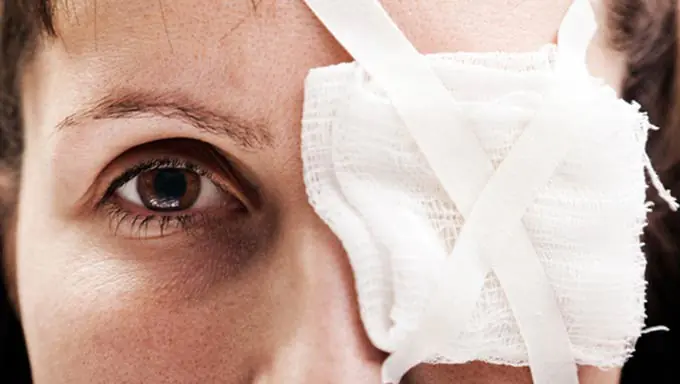
How can you burn your eyes?
Most often, chemical burns to the eyes occur at work. You can injure the mucous membrane at home if you do not follow safety precautions when using household chemicals, lime, and ammonia. Even if a small amount of the substance is used, gloves and special safety glasses must be worn. Regular glasses do not adhere to the skin and leave pathways for irritants to enter.
Eye burns can occur during eyelash extensions. The glue used in the salon is a strong irritant. Contact with it causes swelling, itching, burning, redness and pain.
Chemical burns to the eye are a common consequence of using a gas spray for self-defense. Upon contact with an irritant, blepharospasm may occur, that is, the eye will close abruptly and will not open. Usually the spasm lasts for an hour if the eye is not washed out in time. It is recommended to blink for 5 minutes after rinsing to restore muscle function.
Degree of eye burn
Almost all chemicals can irritate the mucous membranes of the eye, but serious damage occurs upon contact with strong alkalis and acids. Alkali burns occur most often, but they are also the most dangerous, especially with bilateral damage. Often such injuries result in visual impairment.
The severity of a chemical burn will depend on the volume, temperature and concentration of the irritant, duration of exposure and degree of penetration. In some circumstances, the person's age is also important: in general, children tend to have more severe burns.
There are four degrees of eye burn, but the mechanism of damage by alkalis and acids is different. The initial assessment of burn severity is based on the degree of corneal transparency and the severity of ischemia (blanching).
Degree of eye burn:
- First degree (favorable prognosis). It is characterized by the absence of ischemia and the transparent state of the cornea.
- Second degree (good prognosis). Ischemia affects a third of the limbus, there is clouding of the cornea, but details of the iris are visible.
- Third degree (ambiguous prognosis). There is clouding of the corneal stroma, the epithelium is completely lost, ischemia from a third to half of the limbus masks the details of the iris.
- Fourth degree (poor prognosis). Ischemia affects most of the limbus, and there is total opacification of the cornea.
Additionally, the filling of limbal vessels is considered. When determining the degree, the extent of destruction of the corneal epithelium, the presence of symptoms of conjunctivitis, the condition of the lens and iris, as well as indicators of intraocular pressure are also taken into account.

Features of burns with acids and alkalis
Eye burns from sulfuric acid are not as dangerous as from alkali. This is due to the fact that a film of coagulated protein forms on the eye when the irritant reacts with the mucous membrane. The film does not allow acid to penetrate deep into the eye, protecting the eye from deep damage. However, coagulation does not protect against complications if a concentrate of nitric and hydrofluoric acids gets into the eyes. An acid burn is characterized by severe pain, and sometimes even painful shock.
It is noteworthy that when the eye is damaged by alcohol, a person experiences severe pain, but minimal damage is noted. However, alcohol can absorb moisture from the lubricating fluid and the eyeball, penetrating deep into and damaging the cornea and lens. If washed in a timely manner, there will be no consequences for vision.
The most dangerous are alkali burns. In this case, there is severe dehydration and cell destruction. Alkalies provoke the decomposition of protein structures, wet necrosis develops, and when the irritant gets into the intraocular fluid, the deep structures of the eye are affected. Alkali can reach the corneal stroma and trabecular meshwork. As a result, the cornea becomes cloudy and intraocular pressure increases.
Common symptoms of a chemical burn
- Deterioration of vision. The initial decrease in visual acuity is caused by epithelial defects, increased lacrimation, clouding and discomfort. Even with moderate to severe burns, vision may be preserved if the corneal clouding is minor, but severe deterioration will occur over time.
- Fragments of the irritant in the arches of the outer shell. Residues of foreign matter are visible when plaster and other solid irritants enter the eye. The fragments must be removed immediately, otherwise they will continue to release toxins and worsen the damage. Only after cleansing the eye does the natural recovery process begin. Carbide and lime are the most dangerous because they dissolve in the tear and cause severe damage. If these substances come into contact, do not delay cleansing.
- Increased intraocular pressure. A sharp increase in pressure occurs due to deformation and contraction of collagen fibers in the anterior part of the eyeball. Subsequently, the increase is associated with inflammation.
- Inflammatory process in the conjunctiva. Even with mild damage, swelling and redness of the mucous membrane is noted. Sometimes when a burn occurs, the color of the conjunctiva changes (brown when affected by chromic acid, yellowish when exposed to nitric acid).
- Perilimbal ischemia. Based on the degree of blanching, one can make a prediction about the restoration of the cornea, because limbal sprout cells restore the epithelium. Severe ischemia indicates an unfavorable course of the process.
- Cloudiness. If the cornea is transparent, a zero degree of damage is determined, and if the cornea is completely clouded, the fifth degree is determined. Complete stromal opacification makes it impossible to examine the anterior chamber of the eye.
- Defects of the corneal epithelium. Damage to the cornea can be expressed as diffuse punctate keratitis or complete absence of the epithelium. In the latter case, the defect is poorly stained with fluorescein and may not be diagnosed. If the epithelial defect is not visible during the initial examination, prompt re-examination is recommended.
- Corneal perforation. The symptom appears a few days after a severe eye burn, when the cornea's ability to regenerate decreases.
- Inflammation in the anterior region. The reaction may affect single cells or have a pronounced fibrinoid form. Inflammation is more pronounced when alkali gets into the eye, since these substances can penetrate deep into the structures.
- Scarring or other damage to the conjunctiva and eyelids. The symptom may be a problem if scarring prevents the palpebral fissure from closing.

What to do if you have a chemical burn to the eye
Before providing first aid, you need to transfer the victim to a dark room to minimize the effect of light on the eyes and relieve pain. Folk remedies for chemical eye burns are ineffective, and some can be dangerous. Do not wash your eyes with tea or herbal infusion. It is not recommended to refuse the help of doctors in favor of traditional medicine.
First aid for a chemical burn to the eye:
- Remains of the substance are removed from the eyelids with a cotton swab.
- The eyes are rinsed generously under running water for 15 minutes. It is recommended to additionally wash alkaline burns with a 2% boric acid solution, and acid burns with a soda solution.
- If there is severe pain, the patient should be given an effective pain reliever.
- Instill a 4% solution of novocaine or lidocaine, or a 0.2% solution of chloramphenicol.
- Use a disinfectant (0.25% Levomycetin, Sebizone, Albucid-sodium, Acetopt, Ophthalmite, Gentamicin drops).
Rinsing should last more than 15 minutes. You can use clean water, sodium chloride solution (0.9%) or a weak solution of potassium permanganate. If it is not possible to use a special solution, tap water can be used. Potential infection in the long term is not as dangerous as long-term poisoning from the remnants of the irritant.
Treatment of chemical burns to the eye
The entire process of treating a chemical burn can include both conservative and surgical methods. The main thing is to preserve vision. Patients with severe burns need to be hospitalized immediately. In case of damage to degrees I and II, it is advisable to consult a doctor after providing first aid and follow all recommendations at home.
Stages of treatment for chemical eye damage:
- Removing the irritant. The most important step in emergency care for chemical burns is copious rinsing. If possible, the eye should be anesthetized before rinsing. Local anesthesia reduces pain and blepharospasm. It is advisable to use a sterile buffer solution (normal saline or Ringer's solution).
- Control of the inflammatory process. At the time of damage, inflammatory mediators are released, which provoke necrosis. This process inhibits re-epithelialization and increases the risk of ulcers and corneal perforation. You can interrupt the inflammation with the help of local steroids; citrate or ascorbic acid is additionally prescribed. To inhibit collagenosis and prevent ulcers, 10% or 20% Acetylcysteine is sometimes used.
- Acceleration of regeneration. Full epithelization begins only after the irritant is removed from the eye. Chemical damage causes a temporary increase in tear production and a decrease in future tear production, so it is important to use moisturizers for healing. Ascorbic acid helps restore collagen structure and accelerate corneal regeneration. In some cases, wearing therapeutic bandage lenses is recommended.
Since chemical burns to the eyes are accompanied by severe pain, the victim is prescribed powerful anesthetics. Additionally, anti-inflammatory drugs and drugs that prevent the formation of adhesions are used. Treatment of burns usually begins with tetanus vaccination.

Glucocorticosteroids
If severe inflammation develops during a burn, doctors prescribe glucocorticosteroids:
- Dicaine. Eye drops with leocaine and sodium chloride have a local anesthetic effect, relieve pain and prepare the cavity before surgery. The dosage is determined by the degree of burn.
- Ciprofloxacin. The ophthalmic drug is available in the form of drops or ointment, but in case of a burn, the use of a solution is recommended. Ciprofloxacin has antibacterial and anti-inflammatory effects. The drug is instilled every 15 minutes for the first 6 hours, then every half hour the next day. On days 3-14, the interval is increased to 4 hours. Ciprofloxacin is only allowed in patients over 1 year of age.
- Atropine. For chemical burns to the eyes, this remedy helps reduce pain and prevent adhesions. The active ingredient is atropine sulfate. The drug is instilled three times a day, 1-2 drops.
- Diacarb. The drug in tablet form is prescribed for increased intraocular pressure. The effectiveness of Diacarb is due to the content of acetazolamide, magnesium stearate, povidone, croscarmellose sodium and other substances. Usually prescribed one tablet 3-4 times a day. Diacarb is contraindicated in diabetes mellitus, acute liver and kidney failure, uremia, hyponatremia, metabolic acidosis, hypokalemia, in the first trimester of pregnancy and during lactation. The drug is prescribed to patients over 3 years of age.
- Prednisolone. This glucocorticosteroid is taken only with the permission of a doctor. Usually prescribed one tablet per day. Prednisolone is contraindicated for fungal infections.
Although chemical burns require emergency treatment, the prognosis is often good. If the damage did not affect the deep structures of the eye, and the appropriate measures were carried out in a timely and correct manner, the preservation of vision will be ensured. In some cases, even immediate help does not prevent the formation of an eyesore. Even after successful treatment, scars may remain and affect the quality of vision.
Relieving pain from eye burns
A serious chemical burn does not occur without prolonged and severe pain. At the initial stage, oral analgesics are most often used. The spam of the ciliary muscle can be weakened with the help of cycloplegic drugs.
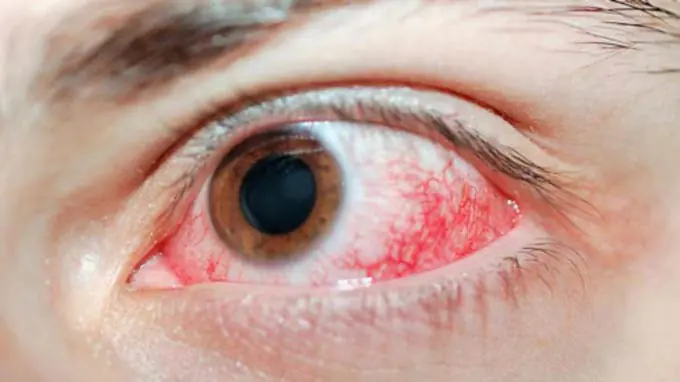
Prevention of secondary infection
If the burn has severely damaged the corneal epithelium, the risk of infection increases. At the initial stage of therapy, antibiotics are prescribed for prophylaxis. Minor, deep corneal injuries can be treated with cyanoacrylate eye glue.
Monitoring intraocular pressure
If elevated pressure levels are observed during a burn, blockers of the production of intraocular fluid are prescribed. Such drugs are indicated both at the initial stage of treatment and during late rehabilitation therapy. When elevated intraocular pressure persists even with the use of antihypertensive agents, surgical intervention (penetrating antiglaucoma or surgery with shunt or valve devices) is required.
Surgical treatment of eye burns and possible complications
If conservative methods are ineffective, surgical treatment of the consequences of the burn is performed. Depending on the complications, a variety of techniques are used.
Surgical treatment for an eye burn may include:
- partial removal of areas of necrosis of the conjunctiva or corneal surface;
- temporary covering with amniotic membrane;
- transplantation of limbal cells or cultured corneal epithelial cells;
- removal of the fusion of the conjunctiva of the eyelids with the eyeball (symblepharon).
To speed up rehabilitation, penetrating or partial keratoplasty and keratoprosthesis are used. If a cataract occurs, it is extracted.
Primary complications of a chemical burn include conjunctivitis, corneal erosion, swelling or clouding, acute increase in intraocular pressure, and melting of the cornea. Secondary complications are usually more varied.
Possible consequences of a chemical burn to the eye:
- glaucoma;
- cataract;
- scarring of the conjunctiva;
- corneal ulcers;
- thinning and tearing of the cornea;
- destruction of the corneal surface;
- opacification and vascularization;
- subatrophy of the eye.
The main measure to prevent burns is to follow safety precautions when working with household chemicals and in production where chemicals are used. It is important to exercise caution and wear safety glasses.
Eye burns are not uncommon. They may be different. But the most dangerous type is a chemical burn to the eye. What is it, what causes it, how can I help a person with burns of varying severity? Let's try to answer these questions.
Main characteristics of injury
A chemical burn is an injury to the eye caused by exposure to aggressive chemicals. First of all, there is damage to the conjunctiva - a thin connective membrane that covers the outer surface of the eye and the back surface of the eyelid. It performs an important function because it releases a special liquid that lubricates the eye and prevents it from drying out. Its damage often leads to impairment and even loss of vision.
Damaging substances
Chemical burns of the conjunctiva are not uncommon these days. According to statistics, 10% of all eye burns are of chemical origin. Most often, damage occurs when aggressive substances come into contact with the ocular surface. Among them are:
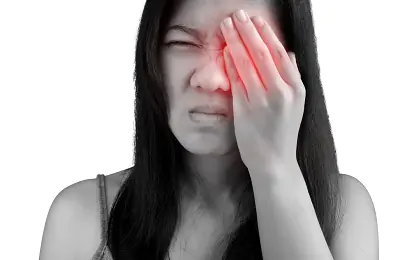
Acids. Most often, burns occur with the following acids:
- hydrochloric acid (HCl);
- sulfuric (H2SO4);
- acetic (HC, COOH);
- hydrofluoric(HF).
An acid burn is similar to a thermal burn. It affects the conjunctiva and cornea without spreading into the eyeball. The degree of damage is affected by the concentration of acids and the duration of their exposure. At the site of acid entry, a necrotic area appears, which is separated from healthy tissue (coagulation). In this case, a very strong pain syndrome appears, since the optic nerves are irritated.
Alkali. The most common alkalis that cause burns are:
- ammonia (ammonium hydroxide);
- caustic soda (sodium hydroxide);
- magnesium hydroxide;
- potassium hydroxide;
- slaked lime (calcium hydroxide).
Burns from alkaline substances are considered more dangerous because the damage extends deep into the eye, from where it is not easy to remove. At the same time, the time of negative impact increases.

This occurs due to the fact that alkali provokes liquefaction necrosis in the proteins, which leads to their melting (myomalacia) and spreading throughout the eye. In this case, the optic nerves are damaged by alkali, which leads to their loss of sensitivity. That is why a person with alkaline burns practically does not feel pain. This often leads to underestimation of damage.
to contents ↑
Risk factors
How do chemical eye burns occur? This occurs through direct contact with acids or alkalis, when, due to carelessness or failure to comply with safety measures, these aggressive substances first enter the area of the conjunctiva of the eye, causing its necrosis (death). Among the risk factors contributing to the occurrence of such burns are:
- Construction or repair manipulations. These types of work often use chemicals that can cause burns.
- Using aggressive substances in everyday life without following safety rules. For example, improper or careless use of ammonia, household chemicals containing dangerous acids or alkalis. It is also risky to leave such substances within the reach of children.

Work involving frequent use of chemicals. This may be the production of concentrated acids and alkalis or other types of work where such substances are used.- Careless behavior with car batteries that contain sulfuric acid concentrate. This is especially true for car enthusiasts who do not have professional skills in working with cars.
- Alcohol abuse. In this state, very often people do not follow safety rules, which leads to unpleasant consequences.
Any type of burn is potentially dangerous. Therefore, first of all, a person needs emergency care for a chemical burn to the eyes.
The sooner it is provided, the more favorable the forecasts will be.
How does it manifest?
The severity of a chemical burn depends on many factors. Among them are:
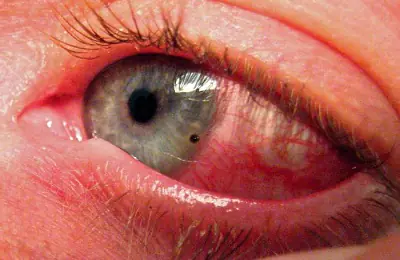
type of chemical (acid, alkali, etc.);- the amount of substance that has reached the surface of the eyes;
- concentration of the chemical (the more diluted it is, the less harm the burn will cause);
- temperature of the substance (the higher it is, the more complex the consequences);
- duration of exposure to the eyes.
The favorable outcome of treatment is also influenced by the patient’s age (the younger the person, the faster the recovery), as well as how timely and high-quality first aid was provided.
There are several degrees of eye damage from chemicals, which differ in the severity of the damage and are manifested by specific symptoms. There are 4 degrees of chemical burns:
The first is considered the mildest degree of burn. Its main features:
- sudden onset of pain;
- cloudiness in the eyes (vision problems);
- the appearance of red blood vessels in the whites of the eyes (hyperemia);
- conjunctival edema (chemosis);
- cloudiness of the fluid in the anterior chamber of the eye.
Healing procedures
For a chemical burn to the eye, first aid involves a set of certain actions. It must be provided on an emergency basis. It’s good if there is a person nearby with a medical education or basic knowledge in this area. But even an ordinary person can help.
First aid
So, what to do for chemical eye burns? There are several stages of emergency assistance:
First, it is urgent to rinse the affected eye (no later than 30 minutes after contact with the chemical). To do this, use a physiological solution of sodium chloride 0.9% (table salt) or a weak solution of potassium permanganate (potassium permanganate). They have antiseptic properties.
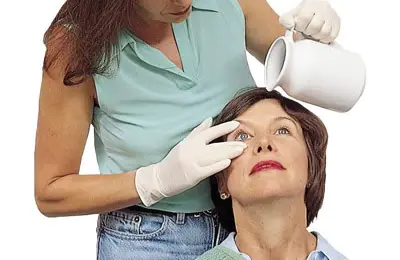
If nothing is available, rinse the eyes with plain water from the inner corner of the eye to the outer corner to avoid chemicals getting into the healthy eye. If there are solid particles of the chemical (lime) in the eye, they should be removed with a dry cotton swab before rinsing.
After all these manipulations, you should cover the affected area with a clean bandage, give the patient a sedative and send him to the hospital, where appropriate treatment will be carried out.
It depends on the severity of damage to the eyeball and the presence of concomitant conditions (inflammation, pain shock and others).
Further therapy
Medical centers offer these procedures to treat eyes damaged by chemicals. First of all, medications are used. Among them:
- local anesthesia for the purpose of carrying out manipulations to remove aggressive substances (Lidocaine);
- antitetanus serum;

antibiotics to prevent infection (drops containing ciprofloxacin, Levomycetin eye ointment);- cycloplegic drugs that reduce pain and prevent scarring (atropine sulfate solution);
- tear fluid substitutes (Lakrisin);
- drugs that reduce intraocular pressure (Timolol, acetazolamide solution);
- glucocorticosteroids (Prednisolone) are prescribed when inflammation occurs.
Additionally, citrates (citric acid salts) or ascorbic acid are prescribed, which improve calcium metabolism in the affected area.
If extensive damage to the eyeball is observed (with burns of 3 or 4 degrees of severity, when defective conditions occur), then surgical intervention may be required:
- tarsography (suturing the skin of the eyelids during healing);
- tissue transplantation;
- autotransplantation;
- keratoplasty (to remove scars);
- prompt correction of the consequences of burns (glaucoma, cataracts).


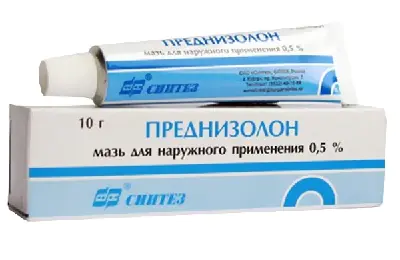
In some conditions (subatrophy - slow death of the damaged eye), keratoprosthesis may be required - replacing the cloudy cornea with an artificial optical device.
Eye burns of chemical origin are common. Most often they are caused by acids and alkalis that enter the eye due to carelessness or failure to follow safety rules when in contact with aggressive chemicals. Such burns should be treated by a qualified physician.
Due to exposure to acid or alkali, a person can receive a chemical burn to the mucous membrane of the eye. Depending on the severity of the chemical burn, the damage is accompanied by clouding of the cornea of the eye, redness of the conjunctiva of the eyelids, and even complete loss of vision.
If an eye injury occurs, first aid is necessary at the very beginning. This will help avoid complications caused by the use of chemicals. A burn to the retina with alkali is more severe than with an acid. Reactions such as tissue death, inflammatory reaction of the anterior cornea, and swelling of the conjunctiva are possible even with mild damage. In this article we will look at what to do in case of a chemical burn to the eyes, what medications are recommended to be used, and how to treat a chemical burn to the eye when providing first aid.
Main reasons

Most often, damage to the organs of vision from chemicals occurs in industrial conditions. Often when welding, calcium carbide is used, which also causes damage. Agriculture involves the use of toxic chemicals that cause damage. However, you can get injured in other situations:
- incorrect use of household chemicals. Young children are often injured if hazardous substances are freely available;
- construction work using chemical reagents (in most cases damage occurs due to lime, ammonia, etc.);
- improper handling of vehicle batteries. The device contains sulfuric acid;
- there is a burn of the cornea of the eyes with pepper spray;
- the damage occurs as a result of a cosmetic procedure for eyelash extensions, which uses glue containing dangerous compounds.
Failure to comply with safety precautions increases the risk of chemicals entering the membrane of the organs of vision, resulting in tissue necrosis. If handled incorrectly, damage may occur from potassium permanganate, known as potassium permanganate.
Burns are caused by acids and alkalis. In the first case, the protein begins to fold, which causes damage in a limited area. With timely assistance, serious consequences can be avoided.
When in contact with alkali, the reagents do not form a scab on the outer areas of the eyes and penetrate deep into the tissue. This can cause vision loss even if you seek medical attention promptly.
Symptoms and complications
Symptoms of an eye burn begin to appear in the first minutes after the surface comes into contact with hazardous compounds. These include:
- the appearance of pain syndrome;
- a burning sensation and a desire to scratch the damaged area;
- increased lacrimation;
- redness of the mucous membrane, as well as the area of skin around it;
- swelling on the face;
- acute reaction to light;
- there is a feeling that there is a foreign object on the shell.
With severe degrees of injury, the effects of burns may become more pronounced. A person cannot open his eyes, blisters with purulent contents appear, and the mucous membrane becomes cloudy. Scars may also appear on the cornea, cataracts or glaucoma may develop, and partial or complete loss of vision may occur.
If first aid is not provided in time for a chemical burn to the membranes of the eyes, irreversible complications may develop. Some occur in the first hours after injury, others - several days after it. The following complications are quite often noted:
- vision deteriorates;
- there is an increase in intraocular pressure;
- a defect in the corneal epithelium occurs, as well as thinning of its tissues;
- an inflammatory reaction occurs in the anterior part of the eye;
- ulcers form;
- There is a gradual death of the organ of vision.
Emergency help
In case of any chemical damage, the first step is to rinse the mucous membrane in order to reduce further exposure to harmful components. To do this, you need to use clean water, preferably from a bottle. You can also rinse with saline or Ringer's solution. There should be a lot of liquid to completely wash out the reagent.
The algorithm for providing medical care includes the following steps:
- washing the affected organ of vision;
- the use of reagents, the choice of which depends on the type of burn - acid or alkali;
- if damaged by cement or other mortars, remove the remaining substance from the shell with a sterile cotton swab;
- Disinfectant eye drops are used.
The main thing with PMP is washing the mucous membrane. It must be done immediately as soon as a harmful substance comes into contact with the cornea. The slightest delay can result in more serious damage. It takes long enough to rinse the mucous membrane to completely eliminate the chemical compound (about half an hour).
If an acid injury occurs, a soda solution is used to normalize the balance. Alkali damage is eliminated by exposure to a 2% boric acid solution. To get rid of large particles, you need to pull back the eyelid and carefully remove the substance. To do this, they usually use cotton swabs soaked in saline solution.
Additionally, you can instill painkillers containing novocaine or icecaine into the victim. A person should be in a darkened room so that the visual organs do not react so sharply to light.
For any degree of damage, it is necessary to call an ambulance and show the victim to a specialist. Before the arrival of doctors, it is allowed to disinfect the tissues using special eye disinfectant solutions. They will help eliminate the first symptoms and avoid complications if you receive a severe chemical burn to the eye. Treatment at home does not involve the use of folk remedies, since medicine recommends treating this type of injury according to the classical scheme.
Treatment
Medications and other methods of recovery should be prescribed by an ophthalmologist. The first remedies include rinsing and removing foreign substances that have entered the cornea. When damaged by chemical components, tissue death occurs, which complicates the healing process. To speed up regeneration, local use of antibiotics and other anti-inflammatory medications is prescribed.
As additional means, drugs are used that disinfect the affected area and also prevent the occurrence of ulcers. Natural tears are also used to prevent the membranes from drying out.
One of the methods of restorative therapy is the removal of dying tissue. This is usually done when the mucosal surface is treated. Such treatment should only be carried out in a medical facility to avoid possible complications.
The following groups of medications are used for treatment:
- painkillers;
- antibiotics;
- natural tear preparations;
- glucocorticosteroids;
- drops that reduce blood pressure, etc.
During the recovery period, attention is paid to how quickly tissue restoration occurs, as well as whether intraocular pressure increases. In serious cases, surgery is used. It may consist of the following actions:
- removal of dying tissue;
- cutting the fused conjunctiva of the eyelids;
- stem cell transplant;
- scar removal;
- correction of existing glaucoma or cataracts;
- replacement of the cornea with an artificial prosthesis.
If the organs of vision are damaged by chemical reagents, it is important to provide timely assistance to the victim. If you remove a dangerous substance in the first seconds, the risk of complications is reduced. The most severe cases of burns can lead to cataracts, glaucoma, and vision loss. However, with a quick visit to a medical facility, these and other pathologies can be excluded.
>



